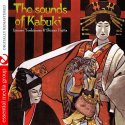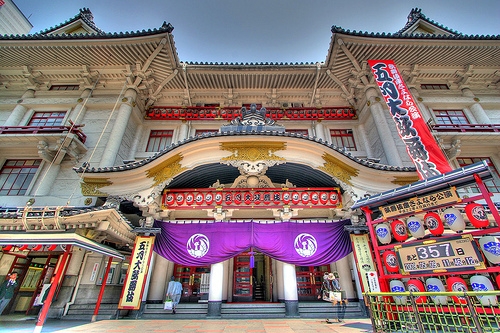Kabuki-za
An 18th Century Kabuki Performance
A trip to the theatre might not be the most obvious way to spend some of your time in Tokyo – but be assured that Japan has theatre unlike that found anywhere else. ‘Noh’ is the oldest and most revered style of Japanese drama, full of highly codified aesthetic principles and subtle word play. Historically it was performed exclusively for the samurai and other members of Japan’s elite, and its minimalist principles were refined over the course of many generations. It can provide wondrous satisfaction for those sophisticated enough to understand it, but unfortunately, to anyone without an in depth knowledge of the art form, it’s more likely to appear dull and boring.
Fortunately, ‘Kabuki’, another form of Japanese theatre, this time aimed at the common people, developed in parallel to Noh. Kabuki is even more distinctive and unique, and, better still, no prior education is needed to appreciate it. In many ways it is the opposite to Noh – gaudy and dramatic rather than subtle and refined. Actors wear elaborate colourful costumes and bright face masks, and express the nature and meanings of their characters using exaggerated poses and gestures. All roles are played by men, but so skilfully do they control their gestures and voices, that it’s often hard to believe that the female characters aren’t played by real women. Kabuki actors are also masters of vocal expression, so much so that much of the meaning of a Kabuki play can be picked up without understanding any of the words themselves. Each performance is accompanied by a small orchestra using traditional Japanese instruments, making Kabuki a true visual and auditory feast.
A key feature of Kabuki is dramatic changes and sudden revelations. Instead of lowering a curtain to allow a change of scene, the whole stage revolves revealing new scenery and actors. Without warning, a character can rise onto the stage through a trapdoor, or fly into the air on a harness. Characters may suddenly reveal their true nature by pulling off their costume Scooby Doo fashion to reveal a new one underneath, and they can do this so smoothly and swiftly that it can seem like a magical transformation. Added to this is the extensive use of props, extravagant scenery, and even acrobatics, making any Kabuki play a spectacle you’re not likely to forget in a hurry.
And so we get to Kabuki-za, Japan’s most famous and grandest Kabuki theatre, dating from 1899 – except that it’s been destroyed and rebuilt four times since then – once by fire, once by earthquake, once by war, and once so a skyscraper could be built on top of it. This is a story typical of most other historical buildings around the country. Don’t worry about not being able to understand anything – the language used in Kabuki plays is so old fashioned that most Japanese people can’t understand it either. The solution? Rent a headset so you can receive an excellent translation into English – along with some background explanations of the cultural context. Japanese people need to use the same headsets to translate old Japanese into modern. Now, when Japanese people decide to do something, they do it properly – no half measures – and Kabuki is no exception: shows typically last about 4 hours! Matinees start at about 11am, and evening shows at around 4pm. If that all sounds too much for you, tickets to watch a single act from the 4th floor gallery go on sale on the day of the performance, but turn up early as they often sell out fast.
Access: Kabuki-za is right in front of Higashi Ginza Station, which is on the Hibiya and Asakusa subway lines.
Web: You can book tickets and get more information about Kabuki-za here.
 The Art of Kabuki
by Samuel L. Leiter.
If you want to understand Kabuki more deeply, this is the book for you.
It’s a collection of five Kabuki plays, along with photos and a
wealth of background information.
The Art of Kabuki
by Samuel L. Leiter.
If you want to understand Kabuki more deeply, this is the book for you.
It’s a collection of five Kabuki plays, along with photos and a
wealth of background information.
 The Sounds of Kabuki
by Ijyuuro Yoshimura and Shinzo Fujita.
There's no need to review this one, as you can listen to it on the
Amazon website and make up your own mind. I bet you've never heard
anything like it before!
The Sounds of Kabuki
by Ijyuuro Yoshimura and Shinzo Fujita.
There's no need to review this one, as you can listen to it on the
Amazon website and make up your own mind. I bet you've never heard
anything like it before!
 Kabuki Costumes Paper Dolls
by Ming-Ju Sun.
Do you remember those paper costumes that you used to dress up
cardboard cut-outs with when you were a kid? Here's your chance to
relive the experience while pretending to educate yourself about
Japanese high culture. What could be more fun? Alternatively, if you
know a top quality Kabuki-related book that I could put here, please
let me know.
Kabuki Costumes Paper Dolls
by Ming-Ju Sun.
Do you remember those paper costumes that you used to dress up
cardboard cut-outs with when you were a kid? Here's your chance to
relive the experience while pretending to educate yourself about
Japanese high culture. What could be more fun? Alternatively, if you
know a top quality Kabuki-related book that I could put here, please
let me know.



